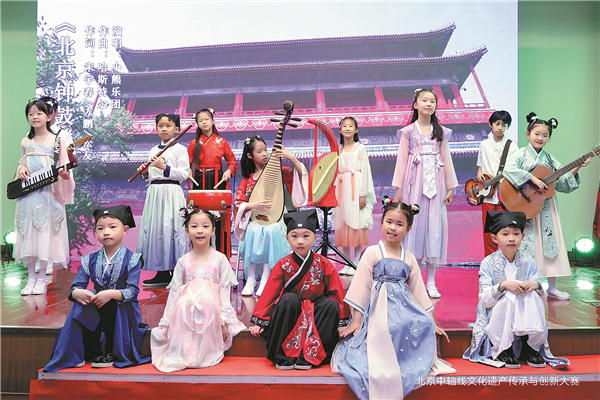

Wu Guangtao, aged 86, sent to the 2022 Competition for the Transmission and Promotion of the Beijing Central Axis a carefully crafted submission, combining thorough research with humanizing tales.
The competition aims to celebrate the Central Axis, or Beijing's old city, one of the world's most remarkable collections of palaces, temples, squares, markets, streets, city walls and towers, built over the course of China's last three imperial dynasties.
Wu's submission, containing valuable photos and detailed accounts of the changes that have taken place in the area and people's lives, is of particular interest as it chronicles not only architectural but also social change in the ancient center.
Wu was born and raised in Beijing's Dongsi district, and after the Dongsi Hutong Museum was established in 2018, he visited it and has been a volunteer there ever since.
Attending a lecture by Lyu Zhou, an expert on Beijing's Central Axis, gave Wu an idea. He thought, instead of talking only about the buildings along the Central Axis, it was more likely to grasp visitors' interest to tell stories about ordinary Beijing residents' everyday lives in the past.
He then started researching and compiling practices and phenomena that have gradually died out. For example, in winters, coal merchants used to turn coal dust into small balls and sell them to nearby residents.
In the award ceremony for the 2022 edition of the competition, hosted on April 2 at the Confucius Temple and the Guozijian (imperial college) Museum in Beijing, Wu was appointed an ambassador for promoting the Central Axis due to his elaborate research and gripping presentations.
"I've always lived in Beijing, and I know that Beijing's Central Axis has rich cultural connotations. It is important to promote these cultural elements and enhance our cultural confidence," Wu says.
Launched in 2021, the annual competition, hosted by the Beijing Cultural Heritage Bureau and the Beijing Office for Conservation and Management of the Beijing Central Axis, has been held twice.
The 2022 competition received a total of 76,419 entries by 90,690 participants from China and more than 30 countries and regions, from which 276 representative projects were selected and awarded.
Select contestants gave performances at the ceremony, telling stories about and expressing their affection for the Central Axis, using various forms of artistic expression, including poetry reading, original musical performances and stand-up comedy.
An exhibition of award-winning pieces was established alongside the event, showcasing cultural merchandise, picture books centered on Beijing's Central Axis, and a virtual reality project that allows the audience to view its sites and buildings.
"Regulations and plans for protecting Beijing's Central Axis have both stressed public participation; that is, cultural heritage should be protected and enjoyed by more people," says Chen Mingjie, director of the Beijing Cultural Heritage Bureau.
"When promoting the protection of cultural heritage, including telling the stories of cultural relics, we have always been talking about introducing profound cultural heritage in lighthearted ways, telling ancient stories with popular means of expression, and introducing heated discussions into this professional field."
The event also marked the opening of the 2023 competition, which continues to focus on inheriting and promoting the culture and history related to Beijing's Central Axis and the capital in general.
Based on the 2022 edition, this year's competition has added more creative categories, including music composition, literature and fashion design, inviting more people to participate in the competition and present ancient culture in innovative ways.
The committee is calling for entries on its official website and social media platforms, including WeChat and Sina Weibo, and the final results are due to be released in October.
The head of the Culture Unit at UNESCO's Beijing Office, Duong Bich Hanh, said at the event that the protection of heritage is a shared responsibility of humanity, and the competition is a great initiative that offers an opportunity for the public to express their efforts and commitment.
"By linking innovation, technology and creativity with heritage, this initiative invites the public to showcase their understanding of and appreciation for not only this important site that lies in the heart of Beijing, but also heritage at large," she says.